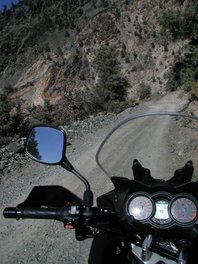Familiar Bike, Demonic Bike
by Joseph Glydon
CityBike, January 1995
Anton Szandor LaVey, in his brilliant discourse on the male psyche, tragically mistitled The Satanic Witch, has a thing or two to say about me and their cars. His perceptions can, of course, be conveniently extended to accommodate motorcycles.
Lavey’s most significant insight is that a man’s (or a woman’s) bike represents either their demonic (opposite) side, or their familiar (similar) side. The demonic motorcycle represents what is inert, suppressed or unresolved in the rider’s persona. Ye Olde Oxford Dictionary defines demon as: “Supernatural, being, inferior deity, spirit, ghost, in-dwelling or attendant spirit...” The word demon does not necessarily relate to evil. In the context of LaVey’s writing, the demonic is regarded to be the hidden self, the unexpressed self. The counterpoint personality below the surface. A familiar motorcycle, on the other hand, like the witch’s traditional familiar, the black cat, has a personality very much like its rider.
The first class or demonic relationship between rider and motorcycle is best demonstrated by the Harley-centered evangelism of otherwise highly-respectable members of the local citizenry. In this case, the motorcycle confers upon its rider the status of Mister Demon, just as twenty-year-old arm candy surrounds the aging middle manager with an aura of virility. The demonic, it seems is the seat of all that one lives irrationally. It is the latent seed of infatuation, the incubator of passion and obsession. If one chooses motorcycles, lovers, or other art forms on the basis of the relentless nudging of the demonic self, pragmatism becomes an unwanted turd in one’s existential soup.
In the clarified broth of contemporary Harley pageantry, all those intimidated little demons have had their day in the sun (Sunday?) parading in mass on runs organized by one benevolent/ corporate entity of another. The demon is leashed, tamed, and home in tame to get the barbecue (barbarian cooker) going. By the way, Anton advises that amorous women not try to compete romantically with a vehicle that answers to a man’s demonic side. It’s too much like breaking up a good marriage.
The fact that Harley riders look so unlike their motorcycles betrays the demonic nature of the attraction. While the bikes themselves are ll color, sparkle and chrome, their riders can only be properly attired in basic black with an authenticating patina of grunge. The motorcycle embodies the radiant, transcendent spirit; the rider is its dark side, its earthbound acolyte. Sacred wounds in form of tattoos, and consecrated (licensed by Willie) garments confirm the humble and enduring reverence of the Biker.
The second class of demonic influence on motorcycle choice is seen among the Ducati enthusiasts. Like Harley thugsters, the Ducati cognoscente are at the mercy of the hidden demon’s need to be heard and seen. But the twist is a little different with Ducatis and other notoriously-demanding exotics: the bike itself mirrors the hidden demon. In the Harley-based relationship, it is the rider who wields the rubber pitchfork, in the case of Ducati, the bike is the bitch.
Sportbikes are the third class of demonic reconciliation on tho wheels. In this instance, the bike and rider are inseparable; combined to synergistically produce a unique entity, fiercer than either of its components. This is a demonic manifestation that writes checks you can cash at most hospitals and police stations. Sportbikes can also function as familiar motorcycles, as in the case of those full-clip testosterone loopers to be mentioned later.
At this point I was considering exploring the demonic aspects of vintage British motorcycle ownership, but hey, Merry Christmas Norton owners.
Moving on to the realm of the familiar motorcycle, the whole scenario changes. It becomes, well, boring. According to LaVey’s thinking, a rider who chooses a motorcycle that’s as reasonable as a moderately well-adjusted human being is probably having his demonic side answered more satisfactorily by a lover, or worse, personal expression. If you think the industry is in the doldrums now, imagine a motorcycle market consisting exclusively of windbreaker-clad transportation riders. Someone so inclined could argue that if humans didn’t come equipped with a demonic side, bikes would have no place as civilian transportation. That someone, however, isn’t me.
You can usually tell a motorcycle that functions as a rider’s familiar, because it either has no image at all, or an image nobody would pay a nickel over MSRP to enjoy. Exceptions to this are the truly anti-social Harley riders, and the aforementioned sportbike youts, who are as ready to display an inappropriate response to accepted behavior as their 160-mph sportbike are to break the speed limit. In both cases, these individuals are likely to have had their riding time curtailed by the need to need to pay social debts in one sort of a correctional facility or another.
The most common species of familiar riders can usually be seen on standard and touring bikes. They don’t want to have have an emotionally-meaningful relationship with riding. The bike becomes an extension of the self. With the exception of fully-coordinated Gold Wing riders, such motorcyclists hardly think about how they look on their bikes-- and it shows.
BMW riders are the most self-conscious familiar motorcycle riders in the world. BMW owners confirm their familiar relationship by their dress. BMW owners and their bikes tend to show an unblinking fashion harmony reminiscent of those married couples who wear identical, very expensive, pastel yacht club sweatshirts or gold outfits. They also depend on their motorcycles to express how mature and well-adjusted they are. BMWs function not just as tools but as tools with a message. Like the career mechanic's monolithic, red Snap-on chest displaying an earthly fortune in premium wrenches, the BMW motorcycle conveys a sense that its owner is a serious and devoted motorcyclists. Of all the marques, the BMW is truest to the spirit of the familiar motorcycle.
Next month: Nortons in purgatory.



